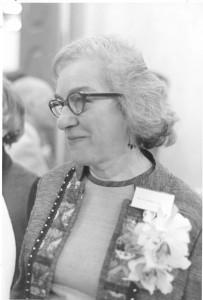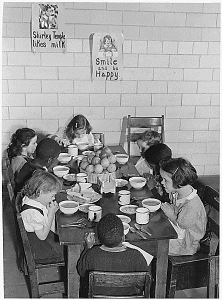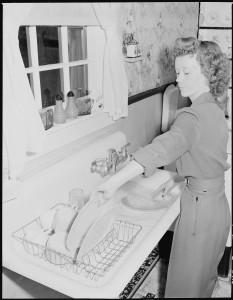Happy birthday, Mollie Orshansky!

(Social Security Administration
Historical Archives)
Today, Ms. Mollie Orshanky, best know for her work on poverty, would have been 100 years old. Her research became the foundation for the Federal Poverty Guidelines. Though this measure has been criticized, it is important to remember Mollie Orshansky’s work was groundbreaking for its time.
On her birthday, it is worth pausing to remember who she was and some of the ways she shaped our understanding of poverty.
Who was Mollie Orshansky (1915-2006)?
The daughter of Ukrainian immigrants, she grew up in New York City with her five sisters.* Although her family had a strong work ethic, her father, at times, struggled to provide for his large family. During these times, Mollie would accompany her mother as she stood in bread lines for assistance in feeding the family.
These early experiences shaped how she thought about poverty and what that economic condition meant to the people in it. When talking about her work on the poverty measure she would often remark, “If I write about the poor, I don’t need a good imagination–I have a good memory.”
In 1935 she was the first person in her family to earn a college diploma when she graduated from Hunter College with a degree in mathematics and statistics. From there she worked at a handful of government organizations looking at family and economic issues. In 1945 she transferred to the U.S. Department of Agriculture where she worked developing a variety of food plans–based on necessary nutrition and food costs–that scaled based on family size and economic conditions. In 1958 she moved to the Social Security Administration, where she remained for the rest of her career.
Poverty Research
In 1963, before the War on Poverty, Orshansky was asked to prepare a report on “Poverty as it Affects Children.” Since there was no accepted measure for poverty, she had to construct her own for the purpose of her personal research. To do so, she relied on a few key assumptions, which still inform how we think about poverty today:

Adequate nutrition matters: As a foundation for her measure, she relied on the the “Economy” food plan she had created at the Department of Agriculture. Not only was it carefully researched and documented, but it provided an empirical argument based on nutritional adequacy for the minimum resources necessary for a family to live. While the Economy food plan would not guarantee that growing children would receive adequate nutrition, those spending less than what was recommended would most certainly face malnutrition.
The Economy food budget was very restricted: It only allowed for one pound of meat per day for a family of four. That equals two chicken breasts for the whole family spread across three meals. In addition, it did not allow for other expenses such as a carton of milk at school, an occasional ice cream bar for children, or any sort of formal or informal entertaining. She had wanted to add 15 cents a day (or $1.16 in 2014, adjusted for inflation) to the plan to allow for a few extra expenses such as these, but the idea did not get past her supervisors.
Once she had the food costs she multiplied it by three, based on research on consumer spending, to arrive at her poverty measure. The Federal Poverty Threshold still relies on this today.
Not all families are the same: While it may seem obvious today that the poverty measure should be adjusted to family size and composition, it was not so obvious at the time. It was widely believed that large families could live on less because they maximized economies of scale. As a child of a large family, Mollie didn’t believe this. She argued that “what passes for ‘economy of scale’ in the large family may in part reflect the lowering of dietary standards enforced by insufficient funds.” Large families were not better at stretching a dollar, they were doing without.
Orshansky also believed that the threshold should be adjusted based on the age of children. Echoing what every mother knows, she argued that it costs more to feed a 16-year-old than a 16-month-old and that the thresholds should be adjusted accordingly. While this was ultimately omitted from her calculations, it points to her assumption that family dynamics vary from household to household.

(photo by Russell Lee)
An available parent: The poverty measure as it stands now is often criticized because it omits the cost of childcare. However Orshanky’s measure of poverty depended on having a member of the household who could devote all her time to making the most of the family’s limited resources. The Economy food plan “assumes that the housewife [was] a careful shopper, a skillful cook, and a good manager who [would] prepare all the family’s meals at home.” In other words, the Economy food plan depended on a homemaker who had the “time and skill” to attend to the food needs of the family, not only cooking three meals a day but also searching for and traveling to the most affordable food available. Living on the Economy plan and meeting the nutritional and material needs of the family was nearly a full-time job. This person also looked after any children, eliminating the need to pay someone else.
In the 1960s the idea that even the poorest families would have a housewife was relatively uncontroversial. In the contemporary debates on poverty and welfare, this assumption of the original poverty measure has become problematic.
Her Legacy
When Mollie Orshansky created her poverty measure it was for the purpose of a research project, not as a national guideline for classifying the poor that would be used, essentially unchanged, for 50 years. When asked to reflect on why her measure was so widely accepted she said, “It appeared when needed.” People, like President Johnson, were ready to do something about poverty and her calculations provided a way to measure it. In addition, because it was based on nutritional adequacy, it provided an empirically founded but also emotional argument for the proposed budget. Preventing malnutrition in children was backed by medical research and evoked compassion.
Even when she released her measure in 1963 (and refined it in 1965) she realized there it was flawed. However, she believed it was important to have a way to identify and asses poverty. She saw her work as an important step in poverty research, not a final product. “I wasn’t doing a poverty line–I was doing what was necessary,” she said.
Despite her own poor childhood, which informed her research, Mollie Orshansky’s original goal was not to solve or address poverty. For her, researching poverty was an assignment, not a crusade. She was doing her job. Yet her careful attention to her work changed the way we think about poverty in this country. Today, her birthday, we honor her for that work.
____________________
* Although The West Wing gets Mollie Orshansky’s biographical information wrong, the conversation about the poverty measure and how it counts the poor is still important.


